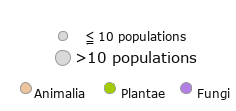Welcome to the Transloc website!
Transloc is an open, collaborative database documenting 1790 translocated populations (to date) of plants, animals, and lichens, with the goal of improving conservation projects through knowledge sharing.
The scope of the database is as follows:
- Geographical scope: Western Palearctic - including Europe and surrounding Mediterranean regions
- Types of translocations: conservation-driven translocations and certain mitigation-driven translocations where population viability is a key objective
- Data content: taxonomic, contextual, organisational, geographical, and demographic information
Translocated population map
Legend

The accuracy of the locations on the map above is approximate (generally at municipality level).